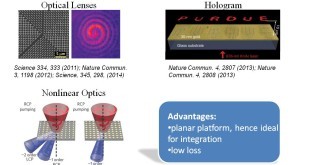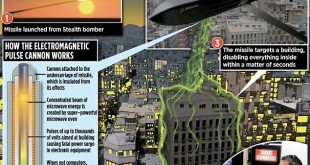Terahertz (THz) waves lie in the electromagnetic spectrum between microwaves and infrared radiation. They are invisible to the human eye. Since they are low in energy, there is no need for be concerned with their impact on human. Today, they play a role in medical and communications technology, but also in materials testing. For example, they were used to inspect the plastic insulation on space shuttle. Terahertz waves are often used in the checking of passengers and luggage at the airport. They are also in demand in other areas, such as for materials testing in the industry.
Despite all these remarkable prospects, a profound exploration of the THz spectral window has been impeded by the lack of efficient THz sources and detectors. Even though considerable progress has been made, certain THz spectral ranges have remained challenging. Thus, new efficient and broadband schemes are needed for THz generation and detection, optimally combining ease of use, durability, flexibility, low cost and scalability.
Electron spins are envisioned to play a key role in future information technologies. Apart from complementing charge-based functionalities, spin-based electronics (spintronics) offers entirely new possibilities. They emerge particularly from spintronic effects allowing for the mutual conversion of charge (or heat) and spin currents. Consequently, widespread applications already exist, including the magnetic random-access memory, which became commercially available only recently. On the other hand, field-effect transistors reaching cut-off frequencies of up to 1 THz have been demonstrated. Moreover, fiber-based telecommunication as well as wireless local area networks are about to reach terahertz bandwidths. This demonstrates the urgent need to transfer spintronic functionalities from the gigahertz into the terahertz frequency range, thereby paving the way towards future spin-based applications at highest speeds.
Physicists at the Technische Universität Kaiserslautern (TUK) have now developed a new method for generating such waves. They use a quantum magnetic current flow, so-called spin current, in magnetic metal nanostructures. The cost-effective and material-saving technology has the potential for industry applications. The study was published in the scientific journal Scientific Reports.
A very efficient and at the same time more cost-effective method has now been developed by Kaiserslautern researchers, in which they use a so-called spin current. This is analogous to the electric current, in which electrical charges, namely electrons, flow. “A spin describes the intrinsic angular momentum of a quasiparticle, such as an electron,” says Associate Professor Dr. Evangelos Papaioannou, who is a researcher with his own sub-group in the Magnetism Research Group lead by Professor Burkard Hillebrands in Department of Physics at TUK. “It forms the basis for all magnetic phenomena. Simply said, an electron rotates left or right around its axis like a spinning top.”
A special nanostructure has been developed by the research team of Papaioannou for the application of the technique. “It consists of a metal bilayer of magnetic iron and non-magnetic platinum,” as the physicist describes the structure. “These are very thin layers that are only a few nanometers thick.”
To generate the terahertz waves, the researchers use a femtosecond laser that emits extremely short laser pulses. As a result, the following happens: “When the laser pulses hit the nanostructure they stimulate the electrons in the iron film, creating a spin current,” says the Papaioannou. This current flows into the adjacent platinum layer. Here comes a certain physical phenomenon into play, the inverse Spin-Hall Effect. For platinum, this effect has been known for some time. It arises due to the atomic structure of the metal. “The atomic nuclei of platinum deflect electrons with a left- and right-handed spin in opposite directions, which leads to the transformation of the spin current into an ultrafast transient charge current, which is then the source of terahertz waves.”
As a special feature of the experimental setup, a small silicon lens is attached to the structure. “We are bundling the waves,” the Junior Professor continues. In this way, the terahertz waves could be forwarded easily and efficiently in future applications.
In their recently published paper, the researchers have revealed, among other things, how layer thicknesses and the arrangement of materials must be best designed to produce the THz waves. The research field of THz spintronics technology is an emerging field. Only recently, research colleagues in Berlin showed for the first time that terahertz waves can be generated by spin current. The work of the Kaiserslautern researchers reveals now a way to optimize the emitters so that they can reach their maximum efficiency. This makes them cheaper and more interesting for various fields of application, for example for security techniques, materials testing and information technologies, but also for basic research.
Researchers are exploiting spintronic effects at THz frequencies to build an efficient and ultrabroadband THz spintronic emitter, based on nanometer-thin magnetic and strongly spin-orbit-coupled
Spintronics realises new terahertz sources
German physicists, along with international collaborators, have realised a new concept for the production of electromagnetic radiation using spintronic emitters. Taking the form of thin, multi-layered, metal films and using the spin property of the electron – as opposed to the more conventional semiconductor emitters, which use only the electron charge – Physicists from the Fritz Haber Institute in Berlin and Johannes Gutenberg-University in Mainz (JGU) have developed the pioneering method by isolating a single unified source of terahertz (THz) emission that could provide useful terahertz radiation over a range of frequencies.
Professor Matthias Kläui of the JGU said: “Using this property, we were able to show that it is possible to produce broadband emitters fully covering the 1‑to‑30‑THz range which are also cost efficient in terms of their industrial applications.” The spin of the electron as a quantum property has led to new developments in spintronics in recent years. The optimisation of emitter performance involved Kläui and his team screening numerous materials with varying compositions and geometries, and was augmented by the calculations of theorists at innovative technology development company Forschungszentrum Jülich.
References and Resources also include:
https://www.sciencedaily.com/releases/2018/02/180201092442.htm
 International Defense Security & Technology Your trusted Source for News, Research and Analysis
International Defense Security & Technology Your trusted Source for News, Research and Analysis


